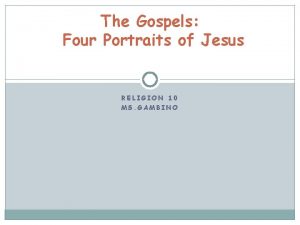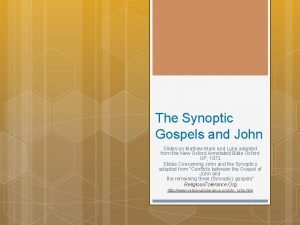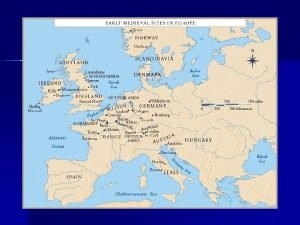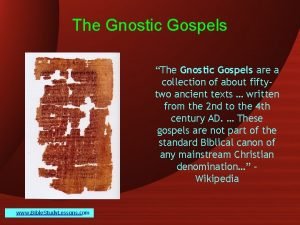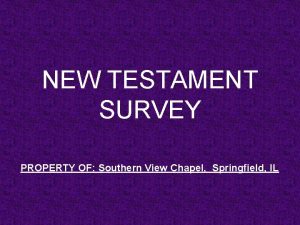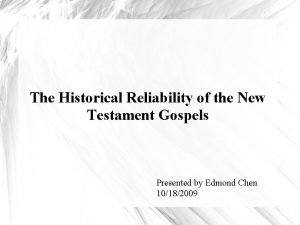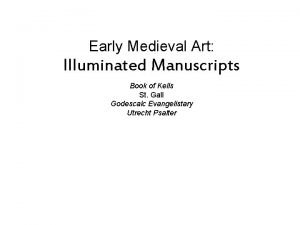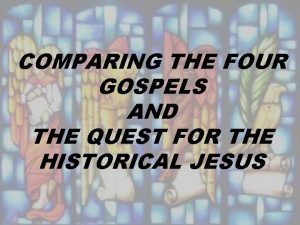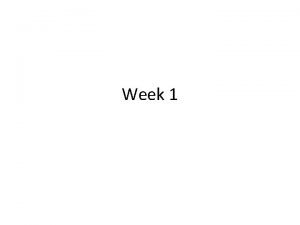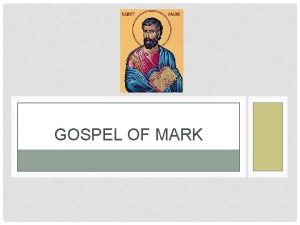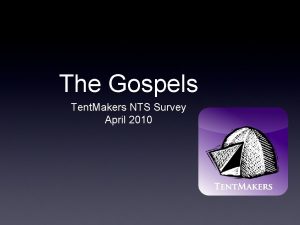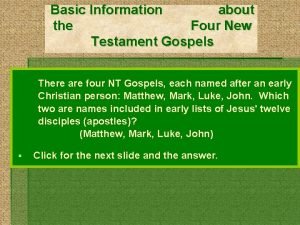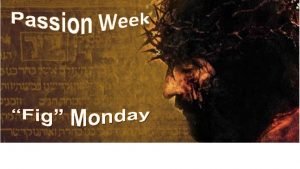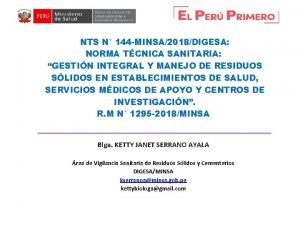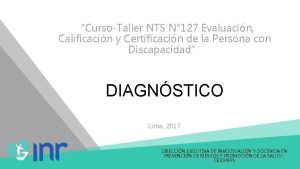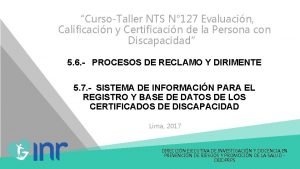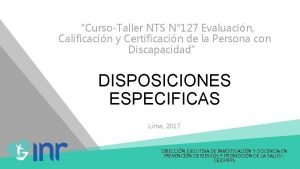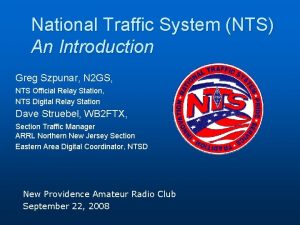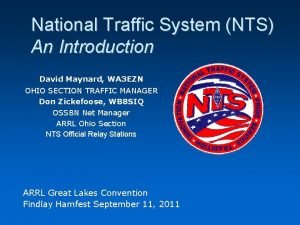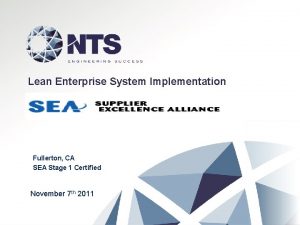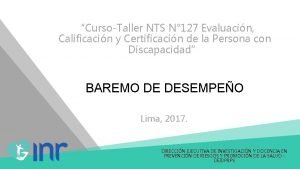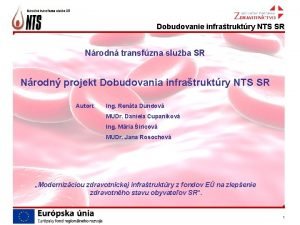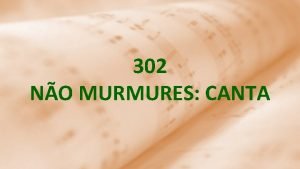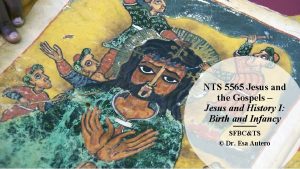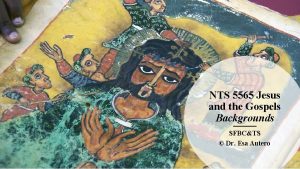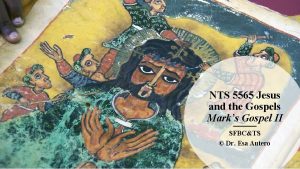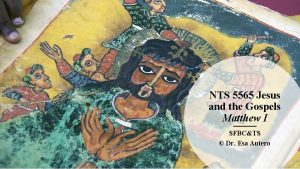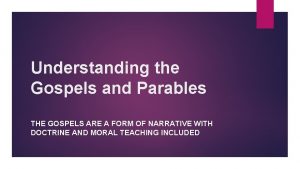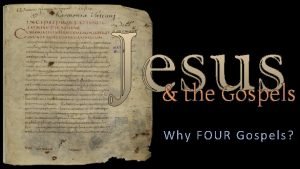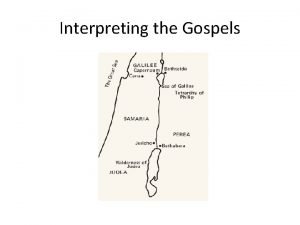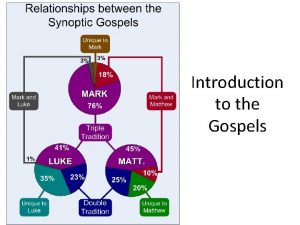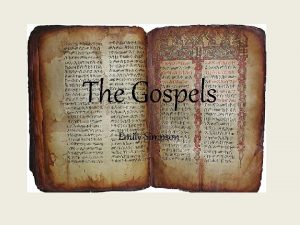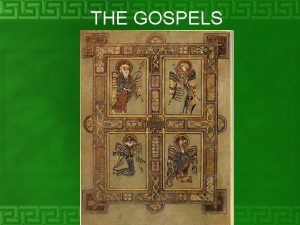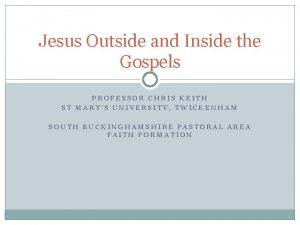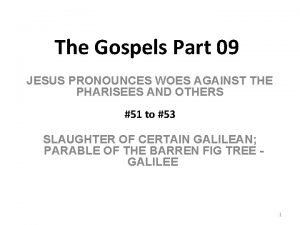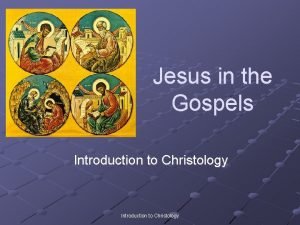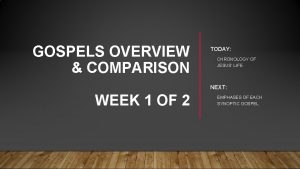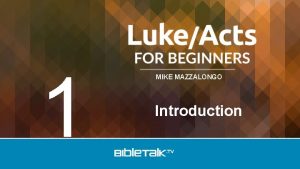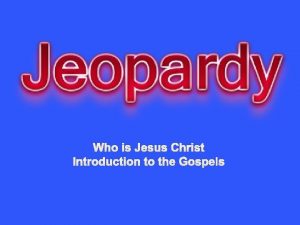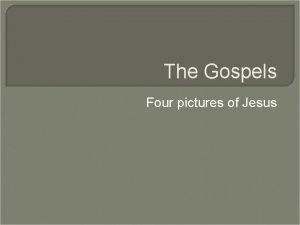NTS 5565 Jesus and the Gospels Trial and













































- Slides: 45

NTS 5565 Jesus and the Gospels Trial and Death SFBC&TS © Dr. Esa Autero

Jesus and the Gospels • Introduction to Jesus’ Last Day(s), Trial, and Crucifixion • What events narrated in the Gospels regarding Jesus Last Days? • Last Supper (Mark 14: 18 -25 par. ) • Foot Washing and upper room discourse (John 13 -17) • Peter’s denial predicted (Mark 14: 26 -31 par. ) • In Gethsemane & Jesus’ arrest (Mark 14: 32 -52 par. ) • Jesus before Sanhedrin & Peter’s denial (Mark 14: 53 -72 par. ) • Jesus delivered to Pilate (Mark 15: 1 par. ) & death of Judas (Matt 27: 3 -10) • Trial before Pilate (Mark 15: 2 -14 par. ) & b/f Herod (Luke 23: 6 -12) • Jesus mocked and flogged (Mark 15: 15 -20 par. ) • Carrying the cross and Crucifixion (Mark 15: 21 -26 par. ) • Mockery on the cross; death and burial (Mark 15: 27 -41 par. )

1. 2 A Chronology of the Passion Week* Sunday (Palm Sunday) Triumphal Entry Mark 11: 1 -11; Matt 21: 1 -11; Luke 19: 29 -44; John 12: 12 -19 Monday Cursing the fig tree Cleansing the Temple Mark 11: 12 -18; Matt 21: 12 -13, 18 -19; Luke 19: 45 -48 Tuesday Withered fig tree found Temple controversies Eschatological discourse Mark 11: 19 -13: 37; Matt 21: 1925: 56; Luke 20: 1 -21: 36 Wednesday Last Supper acc. to John? * OR next day John 12: 1, 12; 13: 1; 18: 28; 19: 14 Thursday Last Supper as Passover meal Betrayal and arrest – trial b/f Caiphas & Annas Mark 14: 17 -26, 43 -72; Matt 26: 20 -30, 47 -75; Luke 22: 14 -30, 47 -65; John 18: 2 -27 Friday Trial by Sanhedrin – trial by Pilate & Herod Crucifixion and burial Mark 15: 1 -46; Matt 27: 1 -60; Luke 22: 66; 23: 1 -54; John 18: 2819: 42 Saturday Dead in the tomb - Sunday Resurrection Mark 16: 1 -8; Matt 28: 1 -20; Luke 24: 1 -53; John 20: 1 -21: 25

Individual accounts differ rather significantly in certain section Jesus and the Gospels 1. 3 Final moments of Jesus’ life prior to the cross • Remarkably similar order of events – Passion source? Matt 26: 26 -27: 23 Mark 14: 22 -15: 15 Luke 22: 14 -23: 25 John 13: 1 -19: 16 Lord’s Upper Foot washing Peter’s denial foretold Dispute about greatness Peter’s denial foretold Gethsemane & arrest Peter’s denial foretold Upper room discourse Jesus before Sanhedrin Purse, bag, sword Jesus arrested Peter denies Jesus Gethsemane & arrest Jesus b/f Annas+Caip. Jesus b/f Pilate Jesus before Sanhedrin Peter denies Jesus Judas’ suicide Barabbas & Jesus b/f Pilate Barabbas & Jesus –

1. 4 Events leading to Jesus’ crucifixion and death • Remarkably similar order of events – Passion source? Matt 27: 26 -66 Mark 15: 15 -47 Luke 23: 22 -56 John 19: 17 -42 Jesus’ flogging No flogging Simon of Cyrene Jesus carries own cross Crucifixion + mockery Crucifixion (9 a)+mockery “Don’t weep for me” Mary + “beloved disciple” Darkness & dereliction Crucifixion + mockery Women & Beloved disciple near the cross Temple curtain & resurrected saints Temple curtain Jesus asks forgiveness & repentant criminal Jesus dies & his side pierced Women observe from distance Darkness (no dereliction) - Joseph. A asks for body & women observe Women observe from distance Guards placed on the tomb - Joseph. A asks for body & women observe Joseph. A asks for body together with Nicodemus

Jesus and the Gospels 2. 1 Last Supper (Mark 14: 22 -25; Matt 26: 26 -29; Luke 22: 15 -20*) • Common and unique features of each account • Mark and Matthew very similar; Luke and Paul (1 Cor 11: 23 -26) similar • John’s Gospel – Foot washing (John 13) & “eating/drinking” (6: 51 -58) • Mark – a Passover meal (14: 12 -21) • Passover meal: Last Supper set-up redemption and salvation • Earlier New Exodus themes (3: 6; 8: 31; 9: 31; 10: 32 -34) & “ransom for many” (10: 45) as preparation • Earlier feeding miracles – allusions to Messianic meal (6: 41; 8: 22) • Bread: “Broke…Take…my body” brief and subtle w/o interpretation • Signals participation of disciples in New Exodus act (m. Pesah 10. 5) – is Jesus taking “aphikomen”? ** (bread reserved for Messiah; later identified as Messiah) disciples acknowledge Jesus as Messiah and “ingesting” it/him

Jesus and the Gospels • • Cup: much longer explanation Action and drinking first – give thanks, gave, drank – then interpretation “my blood…blood of the covenant…poured out for many” Is this the 4 th/last cup of the Passover meal (cf. 1 Cor 11: 25/Luke 22: 20; “after the meal”) – see Mark 14: 17 -21 (“while they were eating”)? • Peculiar thing – common cup to drink (Passover tradition – everyone had their own cup) to emphasize unity and common participation in Last Supper • “blood of the covenant” (cf. Zech 9: 11; Ex 24: 8 [covenant and national formation]) – return-from-exile, New Covenant, and sacrificial language Establishment/seal of the new covenant through Jesus’ death • “blood poured out for many” – sacrificial language alluding to Suffering Servant in Isa 53: 11 -12 with atoning function of Jesus’ death • “until…new day…in kingdom” – ref. to resurrection or 2 nd coming? (Zech 8: 12; Isa 25: 6 -8; 1 En 62. 13 -16; 1 QS VI, 4 -6)

Jesus and the Gospels • Matthew – a Passover meal (26: 26 -29) • Closely related and nearly identical account with Mark -- • Only two specific differences worth noting: • i) Cup – blood poured out for many “for the forgiveness of sins” (26: 68) – Matthew makes explicit what is implied in Mark (14: 24) regarding forgiveness of sins and atoning significance of Jesus’ death* • Also a) alludes to New Covenant more clearly (Jer 31: 31 -34; Matt 2: 18); b) gives closure (1: 21), clarifies, and gives tangible rationale and expression forgiveness (6: 12; 9: 18) • ii) “kingdom of God” in Mark is “my Father’s kingdom” in Matthew; and Matthew includes “with you” – these accords well with Matthew’s theological emphases of God as Father (6: 9 -10) and God-with-you (1: 23; 17: 17; 24: 31; 25: 34; 28: 20) – also eschatological banquets (22: 1 -14; 25: 11 -12)

Jesus and the Gospels • Smaller and less significant differences: “Take and eat” (26: 66 // Mark 14: 22); “Drink from it” (26: 67; “They drank” Mark 14: 23) – perhaps liturgical polishing of Mark’s account • What Matthew retains from Mark & changes fits his theology and themes • Luke – a Passover meal (22: 15 -20) closely related to 1 Cor 11: 23 -26 • Retains similarities w/ Mark and Matthew – yet also many differences • Similarities w/ Mk&Mt: identification of break & wine w/ Jesus’ body & blood; fourfold formula (take, give thx, break, give) • Luke +Mt/Mk – drinking vine in the future (22: 28//Matt 26: 25//Mark 14: 25) and blood “poured out for many” (22: 20//26: 28//14: 24) • Luke +1 Cor: “do in remembrance of me” (Luke 22: 19//1 Cor 11: 24); “did the same…cup poured…new covenant in my blood” (22: 20//11: 25) Luke and Paul highlight the New Covenant aspect of Lord’s Supper*

Jesus and the Gospels • Unique to Luke • Mention of apostles “reclining at the table” (22: 14) – posture of freedom; Jesus’ eagerness to eat the meal (22: 15); expectation to eating bread again at fulfillment (22: 16) • Luke uses the word “apostle” of the disciples (22: 14) – highlighting their post-resurrection task ahead; “kingdom of God” repeated (22: 16, 18) – equation of kingdom with New Exodus (1: 68 -79; 9: 28 -36) • Order of events during the meal – cup taken first (1 st; or at least words over it) and then break. 2 nd Cup taken “after…eaten” (22: 20) – reflects the Passover meal w/ 4 cups at different intervals of the meal. Is Luke’s 2 nd cup reflection of the 4 th (final) cup of the Passover meal cup OR is the same cup held until drank after the bread*? Luke’s the longest of Last Supper accounts

Jesus and the Gospels • “do in remembrance of me” – remembrance of exodus as a key feature of the Passover (m. Pesah 10. 5), here fusing of New Exodus & kingdom Re-actualizes Jesus’ death and resurrection through Passover ritual • New covenant ideas of forgiveness and law in heart (Jer 31: 33 -34) actualized in Luke-Acts w/ forgiveness theme & Spirit’s coming • Luke’s account fits his emphasis on eating & meal scenes (1: 53; 13: 29; 14: 12 -14, 15; 14: 16 -24; 16: 22) • Fits into Luke’s Emmaus rd. meal scene w/ fourfold actions – eyes open at the meal and Jesus vanishes (24: 30 -31; cf. 9: 16) • Luke retains Jesus’ death as sacrificial atonement but highlight also kingdom theme, resurrection, and Parousia

Jesus and the Gospels • John – a Passover meal (John 13 -17 +John 6) • Longest and most unique – no institution of Lord’s Supper though corresponding discourse in John 6 following feeding miracle + foot washing scene • Why John omitted Lord’s Supper and words of institution? • Why foot-washing instead of Lord’s Supper? • What about the timing of the Lord’s Supper?

Jesus and the Gospels • Why did John omit the word of institution in the Lord’s Supper? • i) He was not aware of the tradition • ii) He wanted to keep it secret to prevent casual observers knowing it – like in some mystery religions • iii) John was anti-sacramental – but what about John 6: 51 -58? • iv) John play down sacraments since it had become overly ritualized (Ign Eph 20. 2) – focus of the Last Supper is Christological • v) John knowns synoptic accounts and chooses to not to repeat it – no polemical intent • Other passages that portray, hint, allude to eucharist or its efficacy (John 6: 51 -58) – others more debated 2: 1 -11; 19: 34; 20: 19 -29; 15: 1, 5; 21

Jesus and the Gospels • Why foot-washing (John 13) in place of Last Supper and institution? • Jesus as the servant performing a menial task – model for disciples • Foot-washing as a dramatic commentary of Lord’s Supper – just as Jesus offered himself as a self-giving sacrifice, so disciples should serve one another with self-giving sacrifice. • What about John 6: 51 -58? Is it about the Lord’s Supper? • Sacramental and non-sacramental interpretation – one of the most disputed passages in John’s writings • History of interpretation and effects – esp. from Reformation on • Two basic lines of interpretation • i) Sacramental – “flesh and blood” refer to Eucharist. • ii) Christological – “flesh and blood” refer to Christ

Jesus and the Gospels • Some arguments for each position • Christological interpretation: i) fits well the context; ii) “flesh and blood”, while blood might point to “wine” flesh does not - If John wanted to refer to eucharist why us “flesh” (cf. 1: 14); iii) sacramental interpretation needs to see a discontinuity between previous section; iv) Jesus depicted as the manna from heaven according to pattern of the time (Philo, Leg. 2. 86; Mut. 253 -263; CD-A VI, 4) • Sacramental interpretation: i) John’s audience would recognize symbolism as eucharist; ii) 6: 51 shifts the focus of “bread from heaven” (=Jesus) to Jesus “flesh and blood”; iii) use of “eat” earlier is symbolical but “chew” needs to be understood more concretely Probably Christological reading with eucharistic symbolism is the best option

Jesus and the Gospels • The dating of the Last Supper in John and Synoptics • Synotics clearly portray the Last Supper as Passover meal – night on Nisan 15 (Thursday night) • John indicates Jesus was executed before the evening of the Passover of Nisan 15, i. e. Thursday night; 13: 1; 18: 28; 19: 14) • Despite differences synoptics and John portray the same account • Possible solution to the problem: • 1) John retains the original date – Jesus died on Thursday afternoon when Passover lambs were sacrificed (Nisan 14) Synoptics mistook the time of Jesus’ death by 24 hrs. Unlikely in light of related Passover details in synoptic accounts 2) John gives a wrong date by 24 hrs – by mistake or by theological interpretation and emphasis but what about other correct details in John?

Jesus and the Gospels • Attempts at reconciling the accounts: • i) Jesus ate Passover meal a day early – he knew he would be killed soon • ii) Jesus adhered to a different calendar from that used in the Temple (e. g. followed by Qumran community) No perfect solution available but possible ways to reconcile the differences and similarities

Jesus and the Gospels 2. 2 Gethsemane and arrest • See Mark 14: 32 -52; Matt 26: 36 -56; Luke 22: 39 -53; John 18: 2 -12; cf. 12: 27 -28

Jesus and the Gospels 2. 3 Jesus’ trial • Arrest in Mt. Olives prior to his crucifixion • Interrogation before Jewish leaders & Pilate (and Herod) • Specifics debated but agreement: questioning before Jewish leaders and trial before Pilate before the final verdict of crucifixion Sequence • Trial in Matthew’s account (Matt 26: 57 -27: 26) found in all • Trial begins in Caiphas’ house where leaders convene four Gospel • In the morning before Pilate accounts • Matt also shows: i) responses to Jesus’ Messianic claims (Peter & Judas); ii) responsibility of actors in Jesus’ death (leaders, people); iii) special features – Judas’ suicide & Pilate washing of hands & wife’s dream

Jesus and the Gospels • Before Jewish leaders (Matt 26: 57 -68) • In Caiphas’ house b/f chief priests – Peter in courtyard desiring to know how this ends (cf. 10: 23; 24: 13) • Interrogation – witnesses about Jesus destroying the Temple (27: 40; cf. 12: 6; 21: 12 -13) Jesus does not respond • High Priest gets upset – asks if Jesus is the Messiah and Jesus answers obliquely but affirmatively and quotes Ps 110: 1 & Dan 7: 13 (26: 64) Accusation of blasphemy +abuse Jesus (cf. 5: 39; Deut 18: 20) • Peter’s denial and Judas’ suicide (26: 69 -75; 27: 3 -10) • Sandwiched between Jewish interrogation & Pilate episode • Only Matt includes Judas’ suicide – fulfillment of Scripture and responsibility for Jesus’ death by Judas and leaders (Zech 11: 12 -23; Matt 27: 9 -10)

Jesus and the Gospels • Responsibility for Jesus’ death • Judas and leaders (27: 4); Pilate (27: 24); leaders and crowd (27: 25) Everyone is guilty though all evade responsibility in various ways • Peculiar account of Pilate’s wife’s dream (27: 19) – she does not insist of releasing Jesus because he is innocent but because she is suffering anguish herself (v. 19) representative of selfish motives • Pilate asks “are you king of the Jews? ” – oblique “yes” by Jesus as b/f (cf. 26: 25, 64) • Jesus remains silent b/c of misunderstanding with titles Messiah, king of the Jews, Son of Man – and b/c His fate is sealed beforehand (Isa 53: 7) Pilate hands Jesus over for crucifixion

Jesus and the Gospels • Trial in Mark’s account (14: 53 -15: 15) • Resolves the “Messianic secret” in Mark (14: 61 -62) • False witnesses as in Matthew “Destroy this Temple” connects to earlier scene and words about the Temple (15: 29, 38; 13: 1 -2) • Were there one or two trials before Jewish leaders? ; why was Jesus charged with blasphemy? • Jewish leaders convene again (“consultation…with whole council”, 15: 1) in the morning b/f Pilate’s interrogation (15: 1 -4) • Probably either official affirmation last night’s informal gathering OR finalization of plans to take him to Pilate – depends on understanding of the term συμβούλιον (15: 1)* previous night no two witnesses corroborated per Deut 17: 6; 19: 15 – Mark shows Jesus’ innocence and dubious procedures

Jesus and the Gospels • Blasphemy charges – Jesus guilty only if His statement is false • Not blasphemous to declare to be Messiah – and being Messiah is not a reference to divinity or exalted status • Mark’s readers know the truth about Jesus’ identity as God’s special and unique Son (Mark 1: 1, 24; 2: 5 -7; 3: 11; 5: 7; 8: 29; 9: 41; 15: 39) • Trial before Pilate (15: 1 -15) • “Are you king of the Jews? ” – Jesus accepts royal title (like in Matt) • Jesus remains silent for the rest of the trial (Isa 53: 7) • Mark’s scene corresponds to Matthew but he uses sets of three throughout the account (Mark 15: 2, 4, 9, 12, 14, 11, 13, 14; 14: 35 -36, 39, 41, 68, 70 -71)

Jesus and the Gospels • Trial in Luke’s account (22: 54 -23: 25) • Luke stresses Jesus’ innocence in the trial scene and crucifixion (23: 15, 41, 47) • Luke’s account begins with Peter’s denial – as Jesus taken to interrogation to high priest’s house (22: 54) • Focus on Peter’s denial – and sudden spotlight on Jesus as Peter denies Jesus beating and mocking of Jesus • Interrogation depicted by the council – presumably same location as in 22: 54 • Two questions: Are you Messiah? Are you Son of God? “You say I am” which is understood as “yes” by the council – Jesus further quotes Ps 110: 1 and Dan 7: 13 as before though more briefly Jewish trial shorter than in Matt/Mark

Pilate delays crucifixion verdict longer in Luke and attempts to offer “flog-and-release” repeatedly (23: 13 -25) Jesus and the Gospels • Trial before Pilate and Herod (23: 1 -23) • Charges leveled before Pilate: Jesus leads Israel astray (Deut 13: 1 -5) by claiming to be Messiah and by preventing payment of taxes – both are religious and political charger Jesus’ opponents decided to interpret Jesus’ “tax saying” in negative light due to its ambiguity (20: 20 -26) • Pilate refuses to act but leaders coerce him – Pilate is not “nice” to Jesus or try to release him b/c he thinks Jesus is innocent* • Luke does not try to exonerate Pilate (cf. Luke 13: 1) • Special section – Jesus before Herod (questioned historically) • Herod mocks Jesus by asking a sign – Jesus remains silent • Pilate perhaps desired client king’s support b/c his patron in Rome (Sejanus) fallen into disfavor with emperor Tiberius Sejanus was ani. Jewish and local client king’s support might be helpful politically

John connects Peter’s denial and his Jesus and the Gospels rehabilitation through charcoal fire (18: 18//21: 9) • Trial in John’s account (John 18: 12 -14, 19 -24; 18: 28 -19: 16) • John’s account is a three-way exchange b/w leader, Pilate, and Jesus • Little emphasis on trial of Jesus before Jewish leaders • Order of events: Pilate has Jesus flogged b/f sentencing; trial in two stages w/ each part subdivided into two – i) Jesus b/f Jewish leaders; Jesus before Pilate • i) Jesus before Jewish leaders (18: 12 -14, 19 -24): Jesus taken to Annas’ house (high priest AD 6 -15), Caiphas’ father-in-law (cf. 11: 50) • Peter utters 3 x denials – John informs of 2 nd unnamed man with Peter who is known to high priest’s household – enables Peter’s entry (18: 16) • Contrast b/w Peter’s denial and Jesus’ declaration b/f Annas “always openly” not an official trial since no witnesses present (vv. 20 -22) To Caiphas’ house John omits the scene at Caiphas’ house found int synoptics Peter’s denial

Jesus and the Gospels • Some interesting chronological markers and other peculiarities • Arrest and to Annas’ house at night after Gethsemane arrest • Interrogation at Annas house at least until … 3 am? Perhaps later • Rooster crows as Peter denies Jesus (between 3 am and 5 am) • Jesus transported to Pilate early in the morning for interrogation – signaled by cock crow (18: 28; cf. 20: 1 “early”)* • No mention of trial b/f Sanhedrin, blasphemy charges, “destroy this Temple” or “no taxes” – why? • John includes these elsewhere: Caiaphas and Sanhedrin (11: 47 -53); cleansing of the Temple (2: 19 -22); blasphemy charges, Messiah, Son of Man, Oneness with the Father (10: 22 -39; 1: 51 -53; 8: 58) Did John transpose these OR Synoptics omit them?

Jesus and the Gospels • Jesus before Pilate (18: 28 -19: 16) • At Pilate’s headquarters, Herod the Great’s old palace • Note the chronological markers: “avoid defilement…able to eat the Passover [meal]”; “the Day of Preparation for the Passover” (18: 28; 19: 14) Chiastic structure of the Trial scene in John 18: 29 -19: 16* A Interview with Jewish leaders Jesus must be crucified 18: 29 -32 B Conversation b/w Pilate and Jesus Kings, kingdom, truth 18: 33 -38 a C Pilate to Jewish leaders Jesus is innocent 18: 38 b-40 D Flogging of Jesus Central section 19: 1 -3 C’ Pilate to Jewish leaders Jesus is innocent 19: 4 -8 B’ Conversation b/w Pilate and Jesus Son of God, authority, power 19: 9 -11 A’ Interview w/ Jewish leaders Jesus must be crucified 19: 12 -16

Jesus and the Gospels • Historical Issues in Trial account • Number difficulties in the Trial account – some of the most important ones • General rationale for non-historicity of the account: theological creation of • • • the early church largely based on OT prophecies and texts to bolster claims about Christ’s and His death and resurrection Jesus’ death as a result of triumphal entry and Temple incident – chief priests and Pilate convened together to get rid of Jesus to prevent popular Messianic risings and possible revolt or religio-political unrest Some specific issues about the trial scene: i) Chronology – chief priests would not leave families after Passover meal to have a trial at night. Needed rest after heavy load on Passover duties ii) Pilate’s offer to release Barabbas – no precedents iii) Jewish trial to occur during Preparation of Passover (John) as it is the most exhausting day – required to be in Temple at dawn, not Pilate’s door Inconsistent picture of leaders, Pilate, and crowds; trail b/f Herod

Jesus and the Gospels • Responses and solutions to the question of historicity • Gospels include details that betray eye-witness testimony (John 18: 16) – details • • • that do not fit into evangelist’s theological emphasis Triumphal entry and Temple cleansing confirm Jesus’ Messianic words and actions earlier – not the only ones but climactic explains why the question of Messiah and “false witnesses” before Jewish leaders* Too tired/overwhelmed leaders? – based on modern notions of proper work hours**; underestimate leaders’ desire to get rid of Jesus That Jewish leaders would not hold a case on capital punishment at night is based on m. Sanh 4. 1 – not reliable for pre-70 AD customs. Did the leaders uphold the practice even if it existed in a case like this? Pilate “bending over” for Jewish leaders was for political expediency due to Pilate’s difficult relations w/ Rome during latter part of his rule Herod’s involvement possible – to gain a favor before Rome Barabbas – Governor Albinus (after Festus) released prisoners (Ant. 20. 215)***

Jesus and the Gospels • 2. 4 Death of Jesus* • Crucifixion in the ancient world – “horrific, sadistic, terrifying” • Gospels – most detailed account of crucifixion in ancient world • Crucifixion – a complete degradation of person, unrestrained torture • Most feared form of execution in ancient world – Romans exempted • Crucifixion – crosses in different shapes/forms (†, T, X) • Torture and mockery preceded crucifixion • Victim stripped naked, bound/nailed to the beam w/ outstretched arms • Feet/heels bound/nailed to upright pole & sign placed around the neck or cross to announced the crime (Suetonius, Cal. 32. 2; Mark 15: 2) • Location often outside the city – symbolize utter rejection and ostracism • “lifted up” on the cross – mockery throne for a “wanna-be-ruler”/leader

Jesus and the Gospels • Victim had a seat (sedile) or wooden peg to prolong death by asphyxiation Victim could remain alive for several days (cf. 15: 44) Gospel accounts give us the most detailed account of crucifixion • Description of crucifixion by Seneca: “I see before me crosses not all alike, but differently made by different peoples: some hang a man head downwards, some force a stick upwards through his groin, some stretch out his arms on a forked gibbet. I see cords, scourges, and instruments of torture for each limb and each joint: but I see death also” (Seneca, Marc. 20. 3).

Jesus and the Gospels • Jesus’ death in Mark’s Passion Narrative (15: 16 -41) • Focus on cruel and humiliating death – that reveals God’s plan and Jesus’ true identity (15: 39) – and alerts to meaning of discipleship (cf. 8: 27 -10: 52) • Simon of Cyrene, father of Alexander and Rufus* forced to carry Jesus’ cross – why detailed name? two sons well-known to audience? • Jesus totally helpless: flogging, ridicule, Simon of Cyrene carries cross for Him, parting of clothing, and mocking sign of the cross (cross as “royal throne”)** • Jesus parodied as Hellenistic king by soldiers (Philo, Flacc. 36 -39; Suetonius, Claud. 21: 6) Mark focuses on the brutality of the cross and Jesus’ treatment • “Golgotha” – place of skull (Aram. ). Today associated w/ Church of the Holy Sepulcher OR Gordon’s Calvary near Garden Tomb • Wine mixed w/ myrrh – wine mixed w/ myrrh to dull senses and ease the pain (cf. Prov 31: 6 -7; b. Sanh. 43 a)? Or royal mockery? (Pliny, Nat. Hist. 14. 15. 92)

Jesus and the Gospels • Dividing of clothes – utter shame & disregard of soldiers • “Third hour” (9 a) – super early for all to have happen (cf. John 19: 14, timing noon for Pilate’s verdict). Mark divides the day into 3 -hr. intervals (15: 25, 33, 42)* • Plaque “King of the Jews” – deterrent for other who might try similar • Contempt for Jewish desire for freedom & Jesus’ political charge • God’s servant endures brutal death “as ransom for many” (10: 45) • OT allusions: wine w/ myrrh (15: 23/Ps 69: 21); parting of garments among soldiers (15: 24/Ps 22: 18); crucified among criminals (15: 27/Isa 53: 12); hurling insults (15: 29/Ps 22: 8) • “destroy the Temple…build in three days” – alludes to earlier accusation in 14: 57 -59 and foreshadows the meaning of His death, which is indicated by the tearing of the Temple curtain (15: 37 -38); a doing away w/ the efficacy of old: new access to God • “He saved others…cannot save Himself” – ironic truth that proved true to the extent that “[He] gives life as a ransom” (10: 45); Also true is “Messiah, King of Israel…”

w/ stick – to prolong Jesus’ agony a Jesus and the. Wine. Gospels • Death of Jesus (15: 33 -41) bit more (v. 36). Evokes Ps 68: 22 LXX; cf. Nat. Hist. 23. 27. 54 -55; Plut. Lives, 2. 306 -7 • Darkness from noon to 3 p – “My God…why forsaken” • Darkness alludes to Am 8: 9 (cf. Ex 10: 21 -22) – sign of God’s judgment • Quote from Ps 22: 1 – hopeless suffering and despair, or takes for granted the overall message of Ps 22 of vindication? Bystanders misunderstand “Eloi, Eloi” – signals total blindness of the crowd around the cross; Elijah already came (6: 14 -29; 9: 11 -13) • “Loud cry…breathed last…Temple curtain torn*” – Jesus death not defeat but accomplished something truly significant Veil torn – New access to God through the New Temple • Jesus did not restore or rebuild the new temple (anticipated by tradition) – He provided a completely new access and way to God through His own death and resurrection and coming of the HS

Jesus and the Gospels • Roman Centurion recognizes Jesus as “the Son of God” – at the time of His death as shameful and brutal execution mission Is this ironic? Like demons in the narrative – does Centurion mean “son of god(s)” like a mythic Greek heroes OR does he have a genuine and supernatural revelation of Jesus’ true identity? • Centurion – recognizes the Son of God in the midst of mockery, shame, and cruelty whereas the (lower ranking) soldiers tortured and mocked Jesus; and Jewish leaders handed him over. Anticipates Gentile mission • “Women were watching…” – show courage and devotion in contrast to male disciples who had fled. In ancient world women models of fear and weakness, but not in Gospel tradition.

Jesus and the Gospels • Jesus’ death in Matthew’s Passion Narrative (27: 27 -56) • Matthew follows largely Mark’s narrative w/ few differences • Unique features in Matt’s narrative • Intensification of mockery: “stripped him” (27: 28//15: 17); “scarlet” instead of “purple” cloak – cheaper to intensify mockery (27: 28//15: 17); leaders mock Jesus using Psalm 21: 9 LXX/Matt 27: 43; “if truly Son of God…” (27: 40) • More explicit Scriptural fulfillment + “God’s Son” (Ps 21: 9 LXX/27: 43) • Earthquake and “Tombs opened” (27: 52 -3; cf. Dan 12: 2; Ezek 37: 12 -13)* • No time reference for the crucifixion (Mark = 9 a [“ 3 rd hr. ”], 15: 25) – agrees w/ Mark on “darkness” (“noon to 3 p” [“ 6 th to 9 th hr. ”], Matt 27: 45; Mark 15: 33) Anticipation of Jesus’ resurrection and prefiguring general resurrection at the end

Jesus and the Gospels • Jesus’ death in Luke’s Passion Narrative (23: 26 -49) • Luke’s narrative most unique of the synoptics • Focuses on Jesus’ innocence and vindication • Unique features in Luke’s narrative • Soldier’s abuse and mockery omitted (but see 23: 13 -16) • Crowds wail on the road to Golgotha – “Do not weep for me” (23: 27 -31) • Jesus proclaims forgiveness “not know what they’re doing”* (23: 34) • One criminal recognizes Jesus’ innocence (vindication motif per Isa 53: 8 -10): pleads forgiveness – “Remember me…** Today…in Paradise” (23: 39 -43) • “Darkness” (23: 44) probably also demonic darkness in Luke due emphasis on Satanic activity in Luke (22: 53 -54)

Jesus and the Gospels • Davidic Psalm of lament at death “into your hands I commit my spirit” (Ps 31: 5//23: 46) indicating trust in God • Centurion glorifies/praises God as he recognizes Jesus as the “truly righteous/innocent man” (23: 47) – glory/praise important in Luke • Crowds’ lament at Jesus’ death “…home beating their breasts” (23: 48) • Jesus’ death in John’s Passion Narrative (19: 17 -37) • John’s account focuses on God’s love of the world as manifested in Jesus’ death – also cosmic conflict w/ Satan important as well as God’s sovereign control over the events that take place • Pursuit to kill Jesus more prominent throughout (5: 18; 7: 11; 10: 39; 11: 56) • Unique features in John’s narrative • Jesus explicitly portrayed as the Passover lamb (1: 29)

Jesus and the Gospels • Jesus carries his own cross – in charge of everything, including his death (19: 17; 19: 30 “It is finished”) • Plaque written in three languages* – read by many (19: 19) • Dies at the time of sacrificial lambs slaughtered (19: 14) • “basin and hyssop” allude to sacrifice and Temple (19: 29 -30; cf. Ex 12: 22) • “blood” from Jesus’ side (19: 34) alludes to Passover blood ritual (Ex 12: 13, 22) • Jesus’ legs not being broken alludes to Passover lamb (19: 31 -33, 36; Ex 12: 46) Understood in light of 1: 29 and OT Passover ritual • Jesus’ clothes specified as seamless tunic (19: 24) • Words between Jesus, Mary, and beloved disciple (19: 25 -27; cf. Mark 15: 40) • “I am thirsty” and Jesus drinks “sour wine” to fulfill Scripture (19: 28 -29) • “It is finished” – “gave up his spirit” (19: 30) • Special Scriptural fulfillment (19: 36 -37//Ex 12: 46; Num 9: 12; Ps 34: 20; Zech 12: 10)

Jesus and the Gospels • Jesus to be put to death for being “Son of God” and clashing w/ Emperor’s claims (19: 7, 12, 15) • Pilate or leaders not in control of Jesus’ death – God is, and Jesus Himself (18: 9, 32; 19: 24, 28, 36 -37; cf. 10: 17 -18) • Jesus’ death an expression of God’s love (3: 14 -16); defeats Satan as Jesus is being “lifted up” (12: 31 -32)

Jesus and the Gospels 7 Sayings of Jesus from the Cross – possible harmony • Example – “harmony” of Jesus’ words Luke of diachronic reading. John Matthew/Mark 1. ) “Father, forgive them, for they know not what they 2. ) [to his mother], “Woman, do. ” (Luke 23: 34) behold, your son!” 27 [to the 3. ) “Truly, I say to you, disciple], “Behold, your today you will be with me mother!” (John 19: 26 -27) in paradise. ” (23: 43) 4. ) “I thirst. ” (19: 28) 6. ) “Father, into your hands I commit my spirit!” (23: 46) 7. ) “It is finished, ” (19: 30) 5. ) “Eloi, lema sabachthani? ” which means, “My God, my God, why have you forsaken me? ” (Mark 15: 34//Matt 27: 46 -47)

Jesus and the Gospels • Some question of historicity in the death of Jesus • Many details impossible to proof or find evidence – some sections and details • • • also difficult to harmonize --- yet, also many things credible Darkness that came from noon to 3 p (Mark 15: 33) – attested by Thallus (1 st century Greek Historian) as cited by Sextus Julius Africanus (AD 160 -240)* Or it could be taken as symbolic of God’s judgment(? ) Jesus treatment and crucifixion fit the general patterns found in other sources – flogging (War 6. 5. 3); archaeological evidence for crucifixion** “My God…why forsaken” (Mark 15: 34) – criteria of embarrassment John 18: 31 acknowledges that Jews not allowed to carry out capital punishment – affirmed e. g. by y. Sanh. 1. 1; 7. 2 Outflow of water and blood – realistic picture of death blood from the heart and water from the pericardial sac – occurs immediately after death and just before fluids begin to thicken and the corpse begins to harden – esp. https: //www. apu. edu/articles/15657/

Jesus and the Gospels ἦν δὲ παρασκευὴ*** τοῦ πάσχα, ὥρα ἦν ὡς ἕκτη (John 19: 14) • Note on John’s chronology w/ attempts to harmonizing (see Blomberg 2016): • “They themselves did not enter the governor's headquarters, so that they would not be defiled, but could eat the Passover. ” (John 18: 28) – things to note: i) Jewish “days” started at sundown – if defiled, they’d be clean by the next day (i. e. same evening to eat the Passover meal), but John could refer to noontime Hagigah meal just a few hours away* • Jesus’ crucifixion time: “ 14 Now it was the day of Preparation of the Passover. It was about the sixth hour…handed over to crucified” (19: 14 -15) • “Preparation day of the Passover”: possible to translate “the day of preparation in Passover week” – that is, preparation for Sabbath, not Passover (cf. Did 8. 1; Mart. Pol. 7. 1) – see also John 19: 31, 42 that confirms Sabbath day prep. • “about 6 th hour” = noon (12 p) as opposed to “ 3 rd hour” = 9 a in Mark 15: 24 -5**: i) Time reckoning was estimated by sun (more accurately sun dial when available) generally in quarters (3 rd, 6 th, 9 th, 12 th) – what if the crucifixion occurred around 10: 30 a or so?

Jesus and the Gospels • Responses and solutions to the question of historicity • Gospels
 4 portraits of jesus
4 portraits of jesus Jesus is the sweetest name i know
Jesus is the sweetest name i know Jesus jesus jesus in the morning
Jesus jesus jesus in the morning The date
The date St matthew ebbo gospels
St matthew ebbo gospels Gnostic gospels summary
Gnostic gospels summary Comparison of the four gospels chart
Comparison of the four gospels chart The virgins memo genius
The virgins memo genius The historical reliability of the gospels
The historical reliability of the gospels Chi rho iota page from the book of kells
Chi rho iota page from the book of kells Comparing the four gospels
Comparing the four gospels Synoptic gospels
Synoptic gospels List the synoptic gospels
List the synoptic gospels Synoptic gospels
Synoptic gospels Gospels
Gospels Sunoptic gospels
Sunoptic gospels Four new testament gospels
Four new testament gospels Is the triumphal entry in all four gospels
Is the triumphal entry in all four gospels Norma tecnica 144-minsa/2018/digesa
Norma tecnica 144-minsa/2018/digesa Nts 127
Nts 127 Nts 127
Nts 127 Nts 127
Nts 127 Nts
Nts Nts radio frequency
Nts radio frequency Nts fullerton
Nts fullerton Nts 127
Nts 127 Ipotesi neurotrofica depressione
Ipotesi neurotrofica depressione Hatron
Hatron Nts sr
Nts sr Jesus you are my lord jesus you are my everything
Jesus you are my lord jesus you are my everything No mundo murmura-se tanto harpa cristã
No mundo murmura-se tanto harpa cristã Jesus jesus how i trust him
Jesus jesus how i trust him Historischer kerygmatischer jesus unterricht
Historischer kerygmatischer jesus unterricht Hát kết hợp bộ gõ cơ thể
Hát kết hợp bộ gõ cơ thể Lp html
Lp html Bổ thể
Bổ thể Tỉ lệ cơ thể trẻ em
Tỉ lệ cơ thể trẻ em Gấu đi như thế nào
Gấu đi như thế nào Chụp tư thế worms-breton
Chụp tư thế worms-breton Chúa sống lại
Chúa sống lại Các môn thể thao bắt đầu bằng tiếng nhảy
Các môn thể thao bắt đầu bằng tiếng nhảy Thế nào là hệ số cao nhất
Thế nào là hệ số cao nhất Các châu lục và đại dương trên thế giới
Các châu lục và đại dương trên thế giới Công thức tính độ biến thiên đông lượng
Công thức tính độ biến thiên đông lượng Trời xanh đây là của chúng ta thể thơ
Trời xanh đây là của chúng ta thể thơ Mật thư tọa độ 5x5
Mật thư tọa độ 5x5
